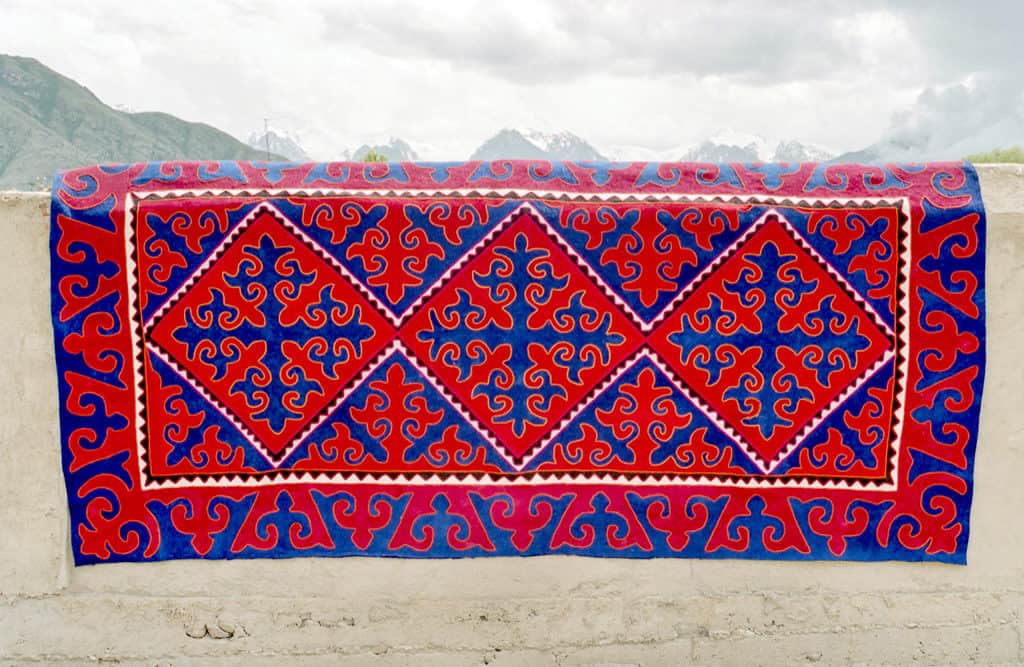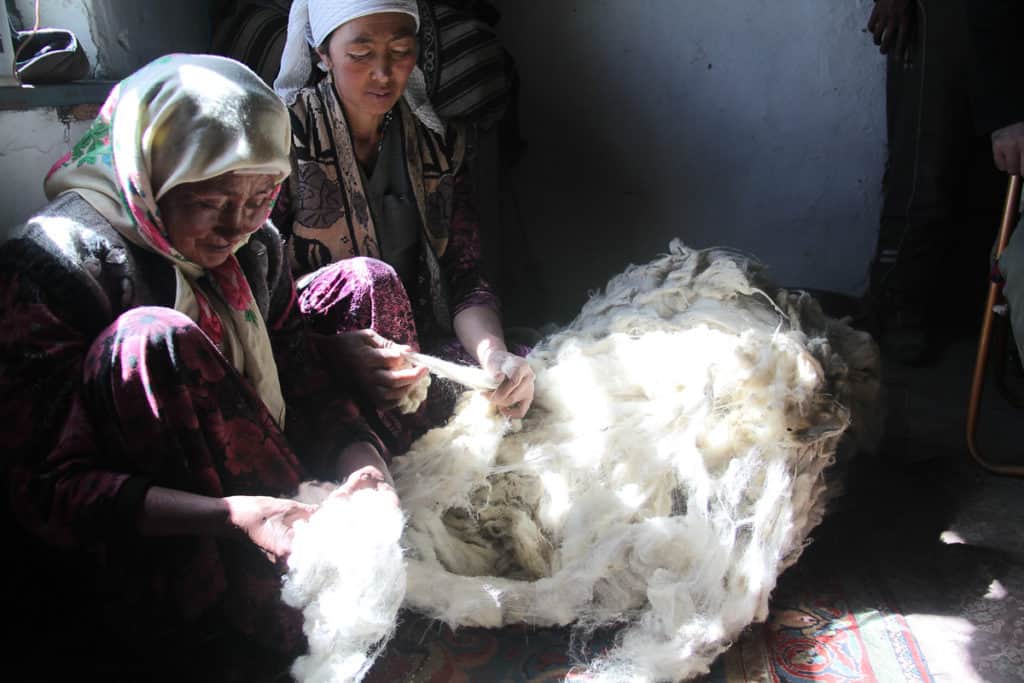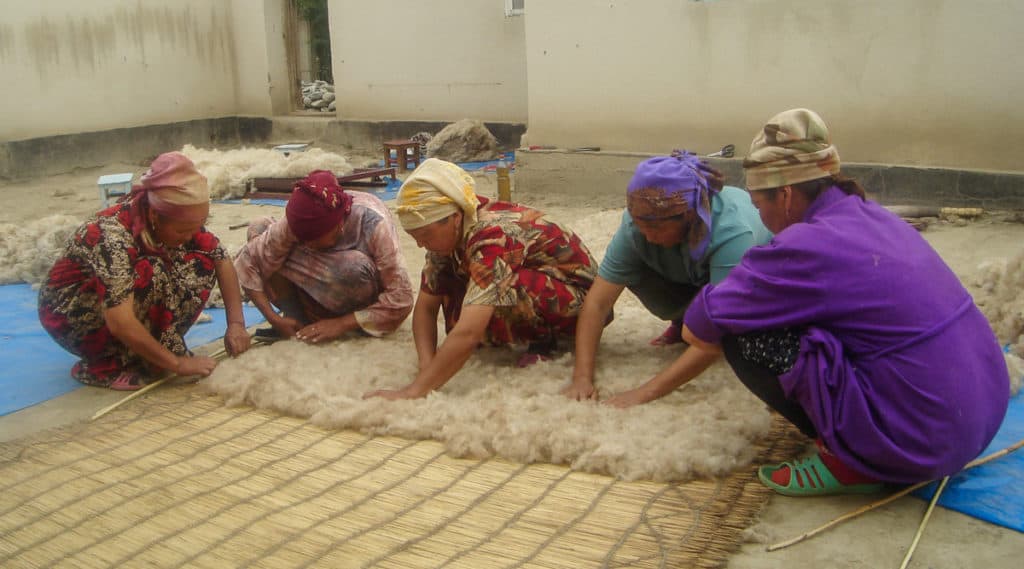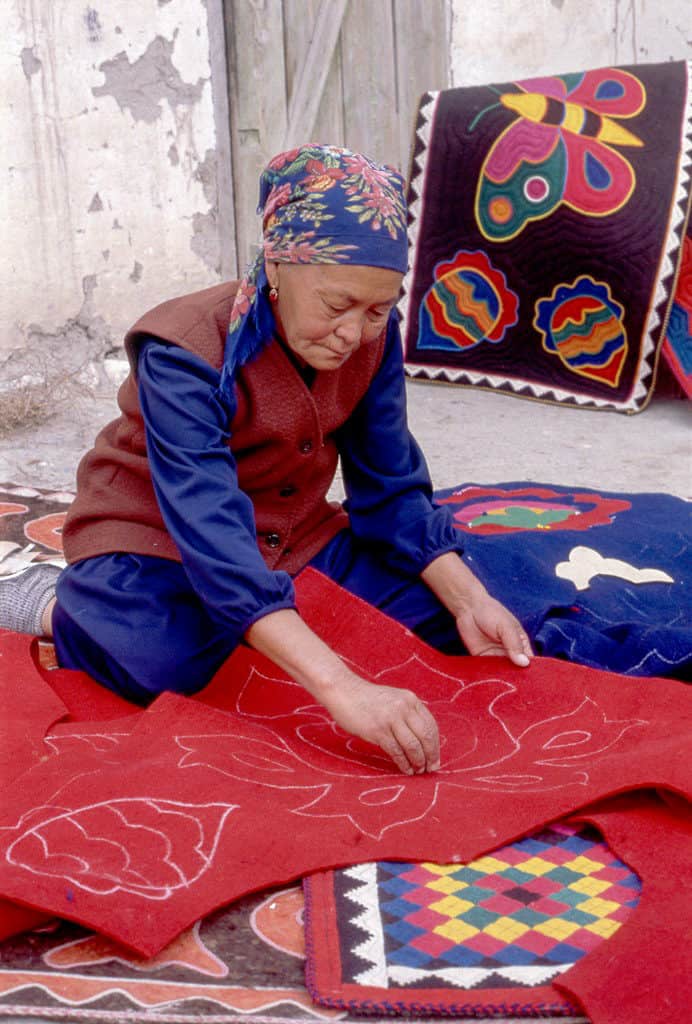
(A message to the reader in Kyrgyz.)
(A message to the reader in English.)
Every early spring when apple and apricot trees bloom and the air is crisp and fresh as past winter’s last breath lingers, one of the most colourful nomadic textile displays take place in Central Asia.
On a particularly sunny day, in every small mountain towns and villages across Kyrgyzstan people start bringing out all of the treasured textiles and hanging them over their wooden fences, mud walls, layout rugs and carpets on the rooftops and in gardens for the sun to dry them, air to refresh and passersby to see. The textiles are ornate and colourful. They include kurak toshok, long and narrow patchwork pieces that kyrgyz people lay on the floor as futons to sit and sleep on; tush kiiyz, intricately embroidered wall hanging that is used to decorate the interior of the kyrgyz yurt and modern homes; juurkan”, thick quilted blankets, taar and kilem, hand-woven carpets; ala kiyiz and shyrdak, woollen felt rugs with colourful ornaments.
As a young girl, I have fond memories of taking part in this annual activity of hanging out textiles with my grandmother Shakil apa, who was a skilled craftswoman. After a laborious few hours, I would lie down to rest on a warm and soft shyrdak under apple and apricot trees.
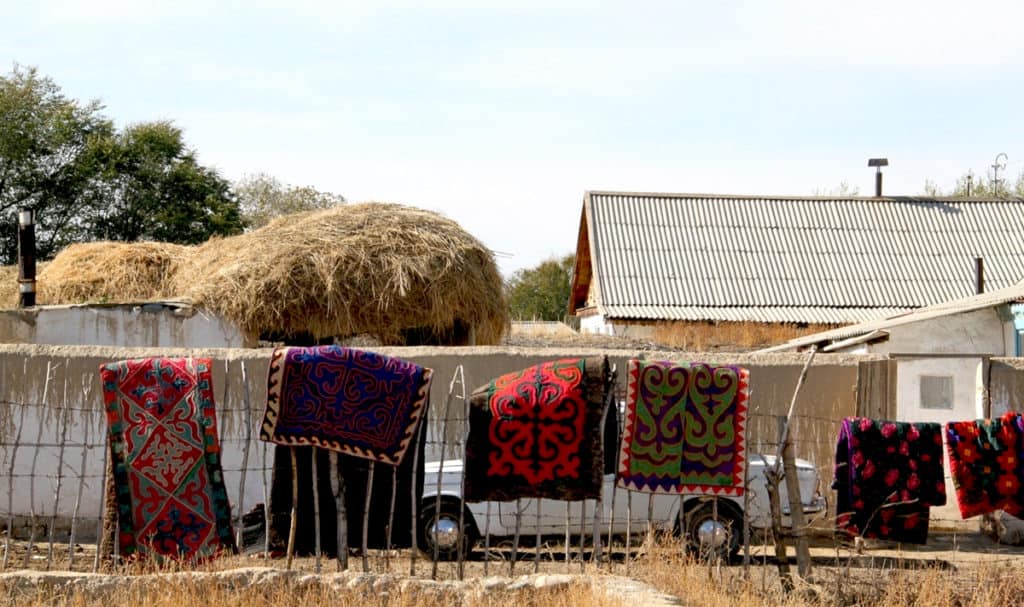
In the Naryn region, Kyrgyzstan, villagers hang their shyrdaks and other textiles outside in early spring.
Little did I know then that I would have the privilege to dedicate a part of my life to reviving, promoting and safeguarding traditional arts and crafts of Central Asia and meet incredible people and inspiring artisans just like my grandmother, Shakil apa, along the way.
There is a variety of Kyrgyz traditional handicrafts. One that stands out is felt shyrdak, a national Kyrgyz rug whose ornament is made according to mosaic technique and is distinguished by a clear pattern, a highlighted contour and colour contrast. The name comes from the word “shyryk”, which means quilting—one of the main processes in the creation, which makes it strong and durable.
For the Kyrgyz, the art of felt making has ancient roots and is known to exist as early as the first millennium BC, when a range of products, processing methods and patterns evolved. As an art form, shyrdak production in Kyrgyzstan has developed continuously over centuries. In present days the felt carpets are produced in two of seven provinces of Kyrgyzstan: Naryn and Issyk-kul. Contemporary craftsmen, producing shyrdaks for local, touristic and international markets, work individually and within groups in co-operatives. Felt rugs were made for the insulation and decoration of yurt dwellings. It was an important element in every household, with aesthetic and magical markings, but also indicated geographic regions and tribal clans. The shyrdak symbolised the concept of well-being, prosperity and peace.
In nomadic life, the process of making felt and felted carpets was a socialising event and unifying factor. It is labour intensive and involves many stages of meticulous preparation, requires time and effort. Felt rugs are the byproduct of animal husbandry. Today shepherds may have as many as 500 sheep in one herd. The quality of the felt depends on the quality of the fleece, which in turn depends on the breed of sheep and condition of the pasture. Thus, the modern-day Kyrgyz continues to be dependent on the state of the environment and the preservation of nature.

The well being of the environment is directly connected to the practice of the handicrafts and cultural traditions. Shepherd herding sheep down for autumn and winter season from higher summer pastures in Issikkul region.
- Men sheer the sheep and help in felt making process, whilst women are responsible for all other aspects of the shyrdak making
- Men sheer the sheep and help in felt making process, whilst women are responsible for all other aspects of the shyrdak making
- Craftswomen preparing dyes and layering wool on “chii” mat in preparation to make felt sheets.
- Craftswomen preparing dyes and layering wool on “chii” mat in preparation to make felt sheets.
Men sheer the sheep and help in felt making process, whilst women are responsible for all other aspects of the shyrdak making.
Production involves the entire family, and sometimes relatives and neighbours. The technical process of felting is accompanied by ritual meals, as well as tales of legendary women whose experience and skills were recalled, while working together. Although men do partake in the process of shearing sheep and felt-making, women were recognised as the authors of the shyrdak, as they performed the initial processing of the wool and production of felt – dyeing, preparation of threads and yarns, the cutting of patterns from felt sheets and sewing them together. The creative component of the process: creation of the ornament, composition and colour combinations was also the women’s prerogative.
The names of the seldom artisans creating today the felt carpets are known all over the country. These masters, led by their inner intuition and in touch with the call of the times, continue to develop the ancient art of the Kyrgyz shyrdak and introduce it to the world. Not every artisan has the knowledge and ability to create and read the patterns, but those who are able to do this enjoy particular respect and admiration. At times you can find such craftsmen among men as well. Artisans with this talent are recognised and often invited to create an exclusive design. More often than not their patterns are copied by other craftsmen.
I must mention Janyl apa, who was one of the most artistic shyrdak makers and a wonderful human being. She has invented her own style known as “Butterfly Shyrdak”. There are others who have also made unusual pieces depicting flora and fauna motives, but none reached the artistic and quality level of Janyl apa from At Bashy town in Naryn region. She has passed on her knowledge to her children who continue to recreate her unique designs keeping traditions and her legacy alive.
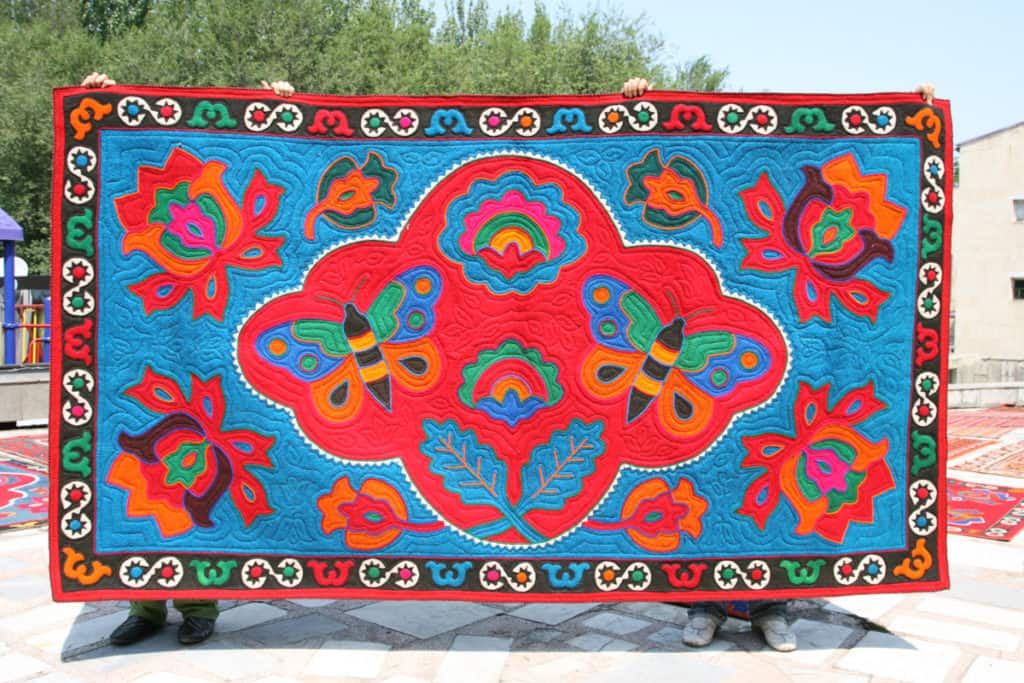
Butterfly shyrdak recreated by Janyl apa’s children and displayed at the annual Shyrdak Festival in Naryn city, 2017.
Pattern plays a key role in the shyrdak. In addition to a decorative function, pattern holds encoded information and magical features. Its function as a protective device is well known. One of the most common ornamental motifs, the triangle (tumar), as well as the black and white “suu-water” border motif, is widely considered to be a talisman that protects from the evil eye.
Pattern is also a visualisation of blessings and wishes for well-being by the artisan, which can be directed toward a specific person. For example, a daughter who is about to get married, other relatives, friends or offspring – children or grandchildren.
The shyrdaks were not intended for sale, but were handed down from generation to generation, ensuring the sacred, ancestral memory of the mother. Therefore the distinct features and ornamentation of each original piece reflected the individuality of the women who created them. It was a matter of honour for every mother to make a shyrdak for each of her children. Also, according to tradition, the bride’s mother makes a shyrdak for her daughter’s dowry. Sometimes the bride herself is involved in the making process. During the wedding ceremony, the shyrdak is shown to the groom’s relatives, accompanied by an explanation of the wishes and blessings embedded in the patterns and solemnly presented to the bride and groom. The newlyweds are required to keep and use it in the course of their long and happy lives. Shyrdaks were also gifted on other special occasions such as house warming celebrations and birth of a child.
These days, shyrdaks have ceased to be a family relic. As a result of urbanisation and globalisation, traditional cultural characteristics have been forgotten. Joint communal labour, unique to traditional nomadic communities, has receded into the past.
Although the shyrdak, thanks to its unique quality and aesthetic characteristics, has received international recognition as an export commodity and cultural brand of Kyrgyzstan, there is a real danger of its disappearance due to the number of craftsmen who know how to produce the shyrdak is decreasing rapidly. The older generation is leaving, taking the culture of felt carpet production with them, in addition to the knowledge and skills necessary for cleaning, dyeing and felting the wool and deciphering of the patterns, considered expendable by modern society.
CACSARC-kg, a non-governmental organization with open membership that unifies and support handicraft communities from throughout the region.
In 2010 Kyrgyz Republic nominated the Kyrgyz felt carpets to be included in the UNESCO List of Intangible Cultural Heritage in Need of Urgent Safeguarding. Experts on culture and artisan community leaders from all regions of the country, headed by the Public Foundation CACSARC-kg, a non-governmental organization with open membership that unifies handicraft communities from throughout the region, with the support of the Secretariat of the National Commission for UNESCO of the Kyrgyz Republic, worked for two years on preparation of the nomination file “The art of making traditional Kyrgyz felt carpets Ala-Kiyiz and Shyrdak”.
At the Seventh Session of the Intergovernmental Committee for Intangible Cultural Heritage, which took place at UNESCO Headquarters in Paris in December of 2012, Kyrgyzstan’s nomination was unanimously supported by other countries, as a unique cultural heritage of the Kyrgyz people and all of humanity that is under threat of extinction and in need of urgent protection.
The inclusion of shyrdak and ala-kiyiz to the List of the World Cultural Heritage of Humanity was a big cultural event in the country and received positive responses in the minds and hearts of all citizens. In Kyrgyzstan, this fact was perceived by the public as recognition of the contribution of the Kyrgyz people to the world treasury of culture and provided a powerful impetus to the activation of the craft movement in all regions of the country.
Only a cultural policy and state strategy that envisages a series of measures to ensure the viability of this heritage will help us to maintain the traditions of ala-kiyiz and shyrdak. This must include the identification, documentation, research, preservation, protection, promotion, and transmission to the next generation through formal and informal education. Only then will the ala kiyiz and shyrdak, the unique Kyrgyz felt carpets that embody beauty in harmony with nature, be conveyed to future generations.
Author
 Dinara Chochunbaeva began as an educator—founding the Republican Center of Aesthetic Education in Bishkek, Kyrgyzstan—and then expanded her concern for promoting the value of intangible cultural heritage to a global stage. She is a Central Asian coordinator and member of International Jury of the UNESCO-World Crafts Council Program “Award of Excellence for Handicrafts Products” since 2004 and Director General of the annual OIMO International Festival on Traditional Crafts and Culture in Kyrgyzstan since 2006. As a national Expert on Intangible Cultural Heritage (ICH) she was pointed as a Head of the national working group to prepare files of Kyrgyz traditional felt carpets Ala-kiyiz and Shurdak and Kyrgyz/Kazakh Yurt have been inscribed into the UNESCO List of ICH in 2012 and 2014, published a book “Shyrdak” in 2015.
Dinara Chochunbaeva began as an educator—founding the Republican Center of Aesthetic Education in Bishkek, Kyrgyzstan—and then expanded her concern for promoting the value of intangible cultural heritage to a global stage. She is a Central Asian coordinator and member of International Jury of the UNESCO-World Crafts Council Program “Award of Excellence for Handicrafts Products” since 2004 and Director General of the annual OIMO International Festival on Traditional Crafts and Culture in Kyrgyzstan since 2006. As a national Expert on Intangible Cultural Heritage (ICH) she was pointed as a Head of the national working group to prepare files of Kyrgyz traditional felt carpets Ala-kiyiz and Shurdak and Kyrgyz/Kazakh Yurt have been inscribed into the UNESCO List of ICH in 2012 and 2014, published a book “Shyrdak” in 2015.

